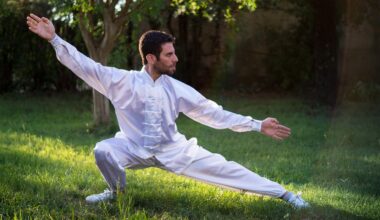Building Core Strength Through Plyometric Movements
Plyometric training is an effective method for building core strength, agility, and power through bodyweight exercises. This type of training employs explosive movements that engage multiple muscle groups simultaneously, promoting overall fitness. Unlike traditional strength training, plyometrics incorporates speed and strength, creating a unique workout experience. Individuals looking to enhance their athletic performance, improve their jump height, or increase stability can benefit greatly from these exercises. Furthermore, engaging in plyometric exercises can help improve coordination and proprioception, which are essential for various sports activities. To get the most out of your plyometric training, it is crucial to maintain proper form and technique. This ensures that you are targeting the right muscle groups and minimizing the risk of injury. Remember that safety should always come first; listen to your body and avoid pushing past your limits. Incorporating different variations of plyometric exercises, such as box jumps, burpees, and jump squats, can help keep your workouts fresh and challenging. Regular practice can lead to significant improvements in core strength, ultimately benefiting your athletic performance and daily activities.
Understanding plyometric movements is essential for those looking to develop a strong core while enhancing overall fitness. These exercises rely on the stretch-shortening cycle, where muscles undergo a rapid stretch followed by a powerful contraction. The core, which includes the abdominal, oblique, and lower back muscles, plays a crucial role in stabilizing the body during these dynamic movements. Strengthening the core is vital for improving athletic performance across various sports and activities. By incorporating plyometric movements into your workout routine, you can strengthen these muscles efficiently while also improving your explosiveness. Some popular plyometric movements that target the core include tuck jumps, medicine ball slams, and lateral bounds. A well-rounded approach to plyometric training can produce a balanced workout that increases strength, speed, and endurance. Moreover, these exercises can be tailored to suit different fitness levels, making them accessible to a broader range of individuals. Beginners can start with lower-impact variations before progressing to more advanced movements as their fitness levels improve. Emphasizing proper technique throughout the workout is key to maximizing the benefits while minimizing the risk of injury.
As plyometric movements demand a high level of energy, it is essential to implement a well-structured training plan for optimum results. A typical plyometric workout should include a warm-up, the main plyometric exercises, and a cool-down phase. Begin by engaging in dynamic stretches and mobility exercises to prepare the muscles and joints for the workout. Once adequately warmed up, choose a selection of plyometric exercises that emphasize core strength, such as plyometric push-ups and depth jumps, ensuring you balance intensity with recovery. Adequate rest periods between sets are crucial for maintaining peak performance and preventing fatigue during the workout. To achieve the best results, aim to include plyometric training in your weekly routine at least two to three times, allowing time for rest and recovery. Listening to your body will help prevent overuse injuries and optimize performance as you adapt to the training. Additionally, combining plyometric exercises with resistance training can provide further benefits during your fitness journey. It is crucial to remember that consistent effort and gradual progression will yield the most significant improvements in both core strength and overall athletic performance.
Progressing Your Plyometric Technique
One of the key aspects of plyometric training is continuous progression. To ensure that your workouts remain effective, strive to increase the intensity or complexity of your exercises over time. This can be accomplished by modifying various elements like the height of jumps or the speed of execution. As your core strengthens, you’ll find you can perform more challenging movements, ultimately enhancing your physical capabilities. Ensuring progress in your plyometric routine is not solely about increasing difficulty; it also involves refining your technique. Focus on optimizing your form during each movement to engage the core effectively. Moreover, integrating various equipment, including plyometric boxes, resistance bands, or stability balls, can provide additional challenges and variation. As you master foundational exercises, consider adding explosive movements that require greater coordination and strength. Recording your progress in a fitness journal or with digital tools can also help you track improvements over time while keeping you motivated. Remember, the goal is not to rush but rather to gradually build your skills while maximizing strength gains. Stay committed and patient – such dedication yields the best results.
Nutrition plays a pivotal role in supporting your plyometric training and overall fitness. Just as your muscles require strength training to grow, they also need adequate nutrition to recover and perform optimally. Prioritizing a balanced diet that includes sufficient protein, healthy fats, and carbohydrates will ensure that your body has the necessary resources for stable energy levels and muscle repair. Adequate hydration is equally essential for maintaining peak performance during workouts. It is essential to replenish fluids lost through sweat to avoid dehydration, ensuring optimal functioning during plyometric exercises. Additionally, consider timing your meals and snacks strategically; consuming a combination of protein and carbohydrates pre- and post-workout can significantly enhance recovery and performance. For optimal results, focus on whole foods such as fruits, vegetables, lean meats, and whole grains while minimizing processed foods. Supplements can also contribute to overall health and recovery, particularly protein powders and amino acids. However, consult with a healthcare professional before beginning any supplementation program. Prioritizing nutrition alongside plyometric training can help provide the foundation for peak fitness and improved athletic performance.
The incorporation of plyometric training into your fitness journey can open up new avenues for growth and development. By enhancing core strength, plyometric movements offer a multitude of benefits, from improved athletic performance to increased overall fitness levels. As you become more familiar with plyometric exercises, consider setting specific and achievable goals. Establishing personal benchmarks can keep you motivated and focused as you work toward enhancing your core strength. Start with measurable goals, such as the number of successful jumps, distances covered in lateral bounds, or even the number of repetitions of specific movements. This can serve as a powerful motivator and help maintain focus in your training routine. As your strength improves, continue to reassess and update your goals to match your progress. A focus on progress not perfection often leads to increased confidence in your abilities. This, in turn, enables you to embrace challenges that go beyond your comfort zone, leading to substantial improvements. Finally, celebrate your milestones and accomplishments along the way as you develop your core strength and overall fitness through plyometric movements.
Conclusion on Plyometric Training
Plyometric training presents a unique and effective path to developing core strength and enhancing athletic performance. By incorporating these explosive movements into your fitness routine, you can build a powerful foundation that aids you in various sports and activities. The benefits of plyometrics extend beyond just physical improvements; they foster mental resilience and determination as you work through challenges, both in your workouts and life. As with any training regime, the key to success lies in consistency and dedication. Approach your plyometric workouts with an open mind, willingness to learn, and a commitment to continuous progression. Ensure that you balance plyometric training with proper rest, nutrition, and hydration to support recovery and strength development. Remember, establishing a sustainable fitness routine is essential for long-term success. Surround yourself with supportive communities or workout partners who share your goals, as they can provide motivation and encouragement. Lastly, always prioritize your safety and listen to your body to prevent injuries. Embrace the journey of building core strength through plyometric movements and derive satisfaction from your growth.


